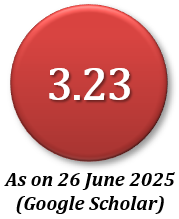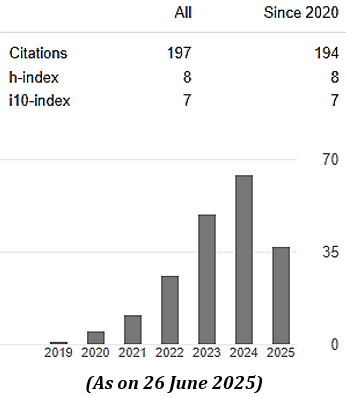Corrosion Behavior of Copper Based Heat Exchanger Tube in Waters of Bangladesh Region at Varied Temperature and Flow Velocity
Abstract
Heat exchangers used in the ships are mostly of water-cooled shell and tube type, whose tube stacks are made of copper-based materials due to the requirement of high corrosion resistance and high thermal conductivity. Even though, the copper made heat exchanger tubes do fail on board ships because of corrosion. More point of contention arises when it is manufactured by companies that have limited supporting data and documentations. In this context, the present paper investigates the corrosion behavior of copper tubes of heat exchanger to assess the life span of the tube stack for on-board applications. A series of experiments have been undertaken to investigate the corrosion rates of copper tubes in sea water and river water with flow velocity of 1.0 m/s, 1.5 m/s and 2.0 m/s for the tube side entry temperature of 20°C. The same experiments have been repeated for the shell side temperatures of 20°C, 40°C, 60°C and 80°C. The investigations have revealed that the corrosion in sea water is about three times higher than that of river water. The increases in temperature and flow velocity have increased the rate of corrosion to a significant level contributing to shorten the life span.
Downloads
References
Abdallah, M. M. A., Maayta, A.K., Qudah, M.A. A. & Rawashdeh, N.A.F. A. (2009). Corrosion Behavior of Copper in Chloride Media, The Open Corrosion Journal, 2, 71-76. doi:10.1016/j.matdes.2008.10.015
Baboian, R. (2005). Corrosion Tests and Standards - Application and Interpretation. ASTM International, Philadelphia, USA
Collini, L. (2012). Copper Alloys – Early Applications and Current Performance – Enhancing Processes. InTech Janeza Trdine 9, 51000 Rijeka, Croatia.
Cramer, S.D. & Covino, B.S. (2005). Corrosion: Materials. ASM Handbook, Volume 13B, ASM International. Materials Park, Ohio 44073-0002 USA.
Davis, J. R. (2001). Copper and Copper Alloys. ASM Specialty Handbook, ASM International, Materials Park, Ohio 44073-0002, USA.
Farro, N. W., Veleva, L. and Aguilar, P. (2009). Copper Marine Corrosion: I. Corrosion Rates in Atmospheric and Seawater Environments of Peruvian Port, The Open Corrosion Journal, 2, 114-122.
Francis, R. (2010). Corrosion of Copper and its Alloys - A Practical Guide for Engineers. NACE International, 1440 South Creek Drive, Houston, Texas, USA.
Gerasimov, V. V., & Rozenfeld, I. L. (1958). Effect of temperature on the rate of corrosion of metals. Bulletin of the Academy of Sciences of the USSR Division of Chemical Science, 6(10), 1192–1197. doi:10.1007/bf01167386
Graedel, T. E., Nassau, K. & Franey, J. P. (1987). Copper patinas formed in the atmosphere—I. Introduction, Corrosion Science, 27(7), 639–657. doi:10.1016/0010-938x(87) 90047-3
Gudas, J. P., & Hack, H. P. (1979). Parametric Evaluation of Susceptibility of Cu-Ni Alloys to Sulfide Induced Corrosion in Sea Water. Corrosion, 35(6), 259–264. doi:10.5006/0010-9312-35.6.259
Hedin, A., Johansson, A. J., Lilja, C., Boman, M., Berastegui, P., Berger, R., & Ottosson, M. (2018). Corrosion of copper in pure O 2 -free water? Corrosion Science, 137, 1–12. doi:10.1016/j.corsci.2018.02.008
Hultquist, G., Szakálos, P., Graham, M. J., Belonoshko, A. B., Sproule, G. I., Gråsjö, L., … Rosengren, A. (2009). Water Corrodes Copper. Springer, Catalysis Letters, 132(3-4), 311–316. doi:10.1007/s10562-009-0113-x
Hultquist, G., Graham, M. J., Szakalos, P., Sproule, G. I., Rosengren, A., & Gråsjö, L. (2011). Hydrogen gas production during corrosion of copper by water. Elsevier, Corrosion Science, 53(1), 310–319. doi:10.1016/j.corsci. 2010.09.037
Hultquist, G. (2015). Why copper may be able to corrode in pure water. Corrosion Science, 93, 327–329. doi:10.1016/ j.corsci.2015.01.002
Hultquist, G., Graham, M. J., Kodra, O., Moisa, S., Liu, R., Bexell, U., & Smialek, J. L. (2015). Corrosion of copper in distilled water without O2 and the detection of produced hydrogen. Corrosion Science, 95, 162–167. doi:10.1016/j.corsci. 2015.03.009
Imai, M., Yamashita, Y., Futatsuki, T., Shiohara, M., Kondo, S., & Saito, S. (2009). Effect of Dissolved Oxygen on Cu Corrosion in Single Wafer Cleaning Process. Japanese Journal of Applied Physics, 48(4), 04C023. doi:10.1143/jjap. 48.04c023
Kong, D., Dong, C., Xiao, K., & Li, X. (2017). Effect of temperature on copper corrosion in high-level nuclear waste environment. Transactions of Nonferrous Metals Society of China, 27(6), 1431–1438. doi:10.1016/s1003-6326(17) 60165-1
Kristiansen, H. (1977). Corrosion of Copper by Water of Various Temperatures and carbon dioxide contents. Materials and Corrosion/Werkstoffe Und Korrosion, 28(11), 743–748. doi:10.1002/maco.19770281102
Kuźnicka, B. (2009). Erosion–corrosion of heat exchanger tubes. Engineering Failure Analysis, 16(7), 2382–2387. doi:10.1016/j.engfailanal.2009.03.026
Lee, S. K., Hsu, H. C., & Tuan, W. H. (2016). Oxidation Behavior of Copper at a Temperature below 300 °C and the Methodology for Passivation. Materials Research, 19(1), 51–56. doi:10.1590/1980-5373-mr-2015-0139
Leygraf, C., Chang, T., Herting, G., & Odnevall Wallinder, I. (2019). The Origin and Evolution of Copper Patina Colou. Corrosion Science. doi:10.1016/j.corsci.2019.05.025
Melchers, R. E. (2001). Temperature Effect on Seawater Immersion Corrosion of 90:10 Copper-Nickel Alloy. CORROSION, 57(5), 440–451. doi:10.5006/1.3290368
Miller, R. L., Bradford, W. L., & Peters, N. E. (1988). Specific Conductance: Theoretical Considerations and Application to Analytical Quality Control. In U.S. Geological Survey Water-Supply Paper. Retrieved from http://pubs.usgs.gov/ wsp/2311/report.pdf
Mor, E. D., & Beccaria, A. M. (1979). Effects of temperature on the corrosion of copper in sea water at different hydrostatic pressures. Congresso Nazionale della Societi, Werkstoffe und Korrosion, 30, 551-558.
Nunez, L., Reguera, E., Corvo, F., Gonzalez, E. and Vazquez, C. (2005). Corrosion of copper in sea water and its aerosols in a tropical island. Elsevier, Corrosion Science, 47, 461–484. doi:10.1016/j.corsci.2004.05.015
Orozco-Cruz, R., Ávila, E., Mejía, E., Pérez, T., Contreras, A. and Martínez, R. G. (2017). In situ Corrosion Study of Copper and Copper-Alloys Exposed to Natural Seawater of the Veracruz Port (Gulf of Mexico). Int. J. of Electrochemical Science, 12, 3133 – 3152.
Pehkonen, S. O., Palit, A., & Zhang, X. (2002). Effect of Specific Water Quality Parameters on Copper Corrosion. CORROSION, 58(2), 156–165. doi:10.5006/1.3277316
Poulson, B. (1993). Advances in understanding hydrodynamic effects on corrosion. Corrosion Science, 35(1-4), 655–665. doi:10.1016/0010-938x(93)90201-q
Rahman, M. M. (2017). An Appraisal of Shipbuilding Prospects in Bangladesh. Elsevier, Procedia Engineering, 194, 224 – 231. doi: 10.1016/j.proeng.2017.08.139
Rahmanto, W. H., Gunawan and Nuryanto, R. (2002). Corrosion rate of copper and iron in seawater based on resistance measurement. Journal of Coastal Development, 5(2), 67-74.
Roy, S., Coyne, J. M., Novak, J. A., and Edwards, M. A. (2018). Flow-induced failure mechanisms of copper pipe in potable water systems. Corrosion Reviews, 36(5), 449–481. DOI: https://doi.org/10.1515/corrrev-2017-0120
Sabri, M. A. M., Sulong, A. B., Chin, F. K. & Sahari, J. (2012). Effect of Corrosion on the Electrical Conductivity of Metals and Polymer Composite, Jurnal Teknologi (Sciences & Engineering) 59, Suppl 2, 81–85.
Schumacher, M. (1979). Seawater corrosion handbook. Noyes Data Corp., Park Ridge, N. J., USA
Simpson, J. P., & Schenk, R. (1987). Hydrogen evolution from corrosion of pure copper. Corrosion Science, 27(12), 1365–1370. doi:10.1016/0010-938x(87)90131-4
Srivastava, A., & Balasubramaniam, R. (2005). Microstructural characterization of copper corrosion in aqueous and soil environments. Materials Characterization, 55(2), 127–135. doi:10.1016/j.matchar.2005.04.004
Szakálos, P., Hultquist, G., & Wikmark, G. (2007). Corrosion of Copper by Water. Electrochemical and Solid-State Letters, 10(11), C63. doi:10.1149/1.2772085
Utanohara, Y., & Murase, M. (2019). Influence of flow velocity and temperature on flow accelerated corrosion rate at an elbow pipe. Nuclear Engineering and Design, 342, 20–28. doi:10.1016/j.nucengdes.2018.11.022
Wan, Y., Wang, X., Sun, H., Li, Y., Zhang, K. and Wu, Y. (2012). Corrosion Behavior of Copper at Elevated Temperature, Int. J. Electrochem. Sci., 7, 7902 – 7914.
Yatsenko, E. A., Zubekhin, A. P., & Nepomnyashchev, A. A. (1999). Protection of copper against high-temperature corrosion. Glass and Ceramics, 56(9-10), 295–297. doi:10.1007/bf02681380
Zakowski, K., Narozny, M., Szocinski, M., & Darowicki, K. (2014). Influence of water salinity on corrosion risk—the case of the southern Baltic Sea coast. Environmental Monitoring and Assessment, 186(8), 4871–4879. doi:10.1007/s10661-014-3744-3
MIJST follows the open access policy.

This work is licensed under a Creative Commons Attribution-NonCommercial 4.0 International License. This allows anyone to copy, share, distribute, and modify the work for non-commercial purposes, where the original work and source should be properly credited.
















